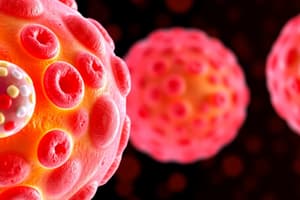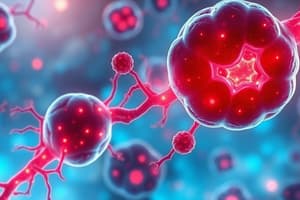Podcast
Questions and Answers
A patient presents with fever, night sweats, unexplained weight loss, and enlarged lymph nodes. Which of the following lymphomas is MOST immediately suggested by these systemic symptoms?
A patient presents with fever, night sweats, unexplained weight loss, and enlarged lymph nodes. Which of the following lymphomas is MOST immediately suggested by these systemic symptoms?
- MALT Lymphoma
- Hodgkin's Lymphoma (correct)
- Burkitt's Lymphoma
- Follicular Lymphoma
A patient presents with enlarged lymph nodes, fatigue, and night sweats. A biopsy reveals the presence of multinucleated Reed-Sternberg cells. Which of the following is the most likely diagnosis?
A patient presents with enlarged lymph nodes, fatigue, and night sweats. A biopsy reveals the presence of multinucleated Reed-Sternberg cells. Which of the following is the most likely diagnosis?
- Non-Hodgkin's Lymphoma
- Hodgkin's Lymphoma (correct)
- Multiple Myeloma
- Acute Lymphoblastic Leukemia
Which diagnostic test is MOST useful in confirming a diagnosis of multiple myeloma?
Which diagnostic test is MOST useful in confirming a diagnosis of multiple myeloma?
- Endoscopy
- Complete blood count
- Urinalysis
- Serum electrophoresis (correct)
A 62-year-old European male presents with a constellation of symptoms. Lab results show malignant B lymphocytes, irregular nuclear contours, positive immunohistochemistry for CD20, CD5, and Cyclin D1. Which lymphoma is most consistent with these findings?
A 62-year-old European male presents with a constellation of symptoms. Lab results show malignant B lymphocytes, irregular nuclear contours, positive immunohistochemistry for CD20, CD5, and Cyclin D1. Which lymphoma is most consistent with these findings?
The presence of Helicobacter pylori is MOST associated with which type of lymphoma?
The presence of Helicobacter pylori is MOST associated with which type of lymphoma?
A pathologist observes a 'starry sky' appearance while reviewing a sample under a microscope. Which type of lymphoma is most likely associated with this observation?
A pathologist observes a 'starry sky' appearance while reviewing a sample under a microscope. Which type of lymphoma is most likely associated with this observation?
A patient diagnosed with Acute Myelogenous Leukemia (AML) has not received treatment. Based on the information provided, what is the expected prognosis?
A patient diagnosed with Acute Myelogenous Leukemia (AML) has not received treatment. Based on the information provided, what is the expected prognosis?
Overexpression of the BCL-2 gene, resulting in immortal cells, is a characteristic of which condition?
Overexpression of the BCL-2 gene, resulting in immortal cells, is a characteristic of which condition?
Which hematologic malignancy is characterized by the clonal expansion of malignant plasma cells?
Which hematologic malignancy is characterized by the clonal expansion of malignant plasma cells?
A patient has tested positive for translocation between chromosome 14 and 18. This genetic abnormality is most likely to be associated with the increased expression of which gene?
A patient has tested positive for translocation between chromosome 14 and 18. This genetic abnormality is most likely to be associated with the increased expression of which gene?
Which leukemia has the MOST favorable prognosis in children?
Which leukemia has the MOST favorable prognosis in children?
Which of the following is a common treatment modality across Hodgkin's Lymphoma, Non-Hodgkin's Lymphoma, and Multiple Myeloma?
Which of the following is a common treatment modality across Hodgkin's Lymphoma, Non-Hodgkin's Lymphoma, and Multiple Myeloma?
A patient presents with symptoms resembling a gastric ulcer, and further testing reveals the presence of lymphoma. Which specific type of lymphoma is most likely indicated by these findings?
A patient presents with symptoms resembling a gastric ulcer, and further testing reveals the presence of lymphoma. Which specific type of lymphoma is most likely indicated by these findings?
Which of the following patient populations has the highest incidence of plasmacytoma?
Which of the following patient populations has the highest incidence of plasmacytoma?
A urine test revealing Bence Jones protein would suggest which diagnosis?
A urine test revealing Bence Jones protein would suggest which diagnosis?
A child is diagnosed with Acute Lymphoblastic Leukemia (ALL). What cell type is primarily affected by this form of leukemia?
A child is diagnosed with Acute Lymphoblastic Leukemia (ALL). What cell type is primarily affected by this form of leukemia?
Flashcards
Lymphoma
Lymphoma
A type of cancer that originates in lymphocytes.
Hodgkin's Lymphoma
Hodgkin's Lymphoma
A cancer that originates from specific lymphocytes called Reed-Sternberg cells.
Non-Hodgkin's Lymphoma
Non-Hodgkin's Lymphoma
A diverse group of lymphomas that do not involve Reed-Sternberg cells.
Multiple Myeloma
Multiple Myeloma
Signup and view all the flashcards
Acute Lymphoblastic Leukemia (ALL)
Acute Lymphoblastic Leukemia (ALL)
Signup and view all the flashcards
Chronic Lymphocytic Leukemia
Chronic Lymphocytic Leukemia
Signup and view all the flashcards
Burkitt's Lymphoma
Burkitt's Lymphoma
Signup and view all the flashcards
Plasmacytoma
Plasmacytoma
Signup and view all the flashcards
Acute Myelogenous Leukemia (AML)
Acute Myelogenous Leukemia (AML)
Signup and view all the flashcards
B-cell Chronic Lymphocytic Leukemia
B-cell Chronic Lymphocytic Leukemia
Signup and view all the flashcards
Mantle Cell Lymphoma
Mantle Cell Lymphoma
Signup and view all the flashcards
Study Notes
Lymphoma Types and Pathologies
- Hodgkin's Lymphoma: Cancer originating in lymphocytes.
- Non-Hodgkin's Lymphoma (NHL): Cancer originating in lymphocytes.
- Follicular Lymphoma: Second most common NHL, cancer originating in lymphocytes.
- Mantle Cell Lymphoma: Rarest NHL, cancer originating in B cell lymphocytes.
- Burkitt's Lymphoma: Cancer originating in B cell lymphocytes.
- MALT Lymphoma: Cancer originating in B cell lymphocytes.
- Multiple Myeloma: Second most common hematological malignancy in the US after NHL, cancer of plasma cells.
Leukemia Types and Pathologies
- Acute Lymphoblastic Leukemia (ALL): Cancer of lymphocytes
- B-cell Chronic Lymphocytic leukemia: Cancer of B lymphocytes
- Acute Myelogenous Leukemia (AML): Cancer of myeloid line of cells
- Chronic Myelogenous Leukemia (CML): Cancer of myeloid line of cells, a type of myeloproliferative disease
Lymphoma Causes, Effects and Diagnostic Tests
- Infection with EBV: May increase risk. Symptoms are systemic. Diagnostic tests include bone marrow and lymph node biopsies.
- Translocation between Chromosomes 14 and 18: Overexpression of BCL-2 gene leading to immortal cancer cells. Diagnostic tests include bone marrow and lymph node biopsies.
- Translocation between Chromosomes 11 and 14: overexpression of cyclin D1 and other symptoms. Diagnostic tests include bone marrow and lymph node biopsies.
- Endemic (malaria), sporadic, immunodeficiency-associated (HIV), EBV infection: Involves jaw and multiple other bones, distal areas and organs. Diagnostic tests include bone marrow and lymph node biopsies or endoscopy.
- Production of a paraprotein: Kidney problems, bone lesions, hypercalcemia. Diagnostic tests include serum electrophoresis, bone marrow biopsy, and x-rays.
Lymphoma Pathogenesis
- Reduced production of functional blood cells: Indicates a failure in blood cell production in the bone marrow.
- Originates in bone marrow, develops in lymph nodes: Describes the development and migration of lymphomas.
- Rapid abnormal growth of chromosomal abnormalities in white blood cells: Describes the uncontrolled growth and abnormalities in white blood cells.
- Increased and unregulated growth of blood marrow and accumulation in peripheral blood: Indicates an uncontrolled, rapid increase of lymphoma in the bone marrow and peripheral blood.
Lymphoma Characteristics
- Multinucleated Reed-Sternberg cell appearance: Indicates Hodgkin's Lymphoma.
- Follicle center B-cells (centrocytes and centroblasts): Relevant to follicle lymphoma.
- Mantel zone surrounding normal germinal center follicles: Features of Mantle Cell Lymphoma.
- Normal B cells or germinal center with rearranged immunoglobulin heavy and light chains: Normal features of B cells or germinal centers.
- Starry Sky appearance: A feature in a specific type of lymphoma (likely NHL).
- Appearance similar to gastric ulcer: May be a distinguishing characteristic.
- Plasmacytoma: A distinct subtype of cancer and appearance features.
- Lymphoblasts: Immature lymphocytes.
- Abnormal lymphocytes: Other immature lymphocytes.
- Basophils and eosinophils increased: Indicates presence of certain leukemias.
Lymphoma Treatment and Survival Rates
- Radiation, chemotherapy, stem cell transplant: Common treatments for various lymphoma types.
- Survival rates: Varied, 5-year survival rates are listed for some types of lymphoma.
- Considered incurable or difficult to treat: Note that the treatment efficacy varies dramatically depending on the subtype and stage.
- Targeted drugs called tyrosine kinase inhibitors: Treatment for some types.
Studying That Suits You
Use AI to generate personalized quizzes and flashcards to suit your learning preferences.



